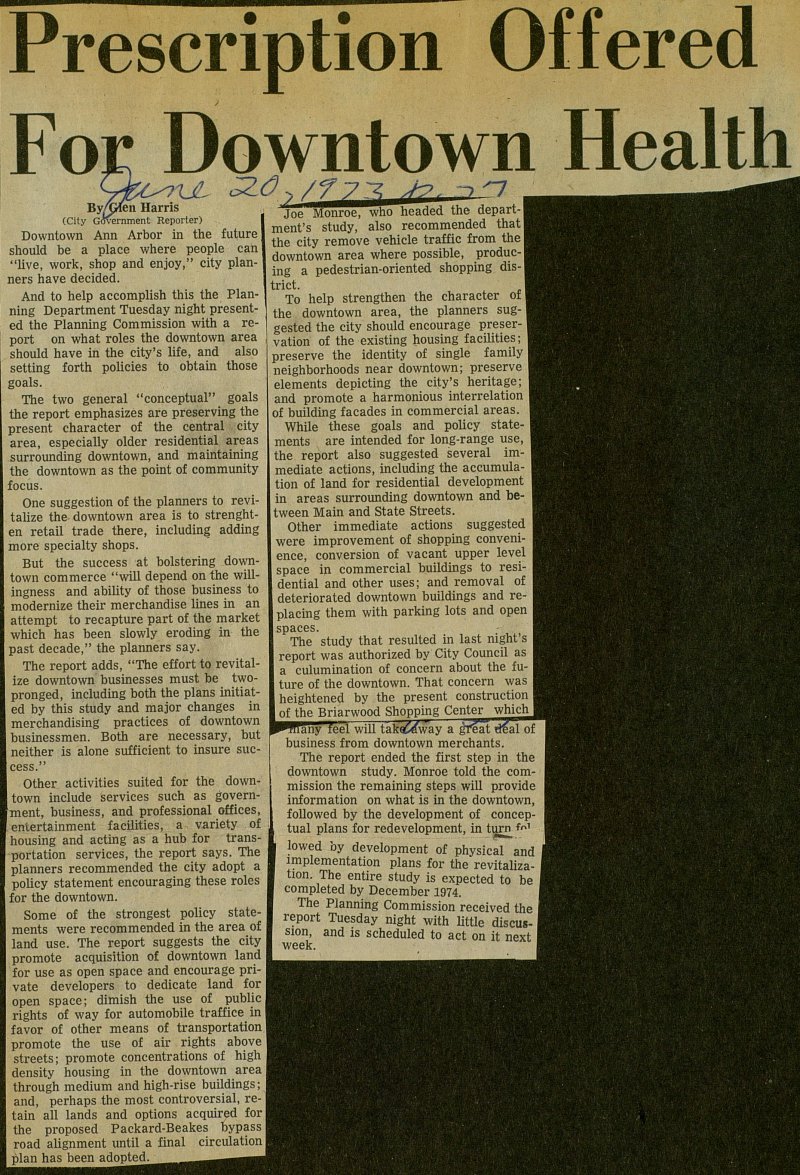Prescription Offered For Downtown Health

Downtown Ann Arbor in the future should be a place where people can "live, work, shop and enjoy," city planners have decided. And to help accomplish this the Planning Department Tuesday night presented the Planning Commission with a report on what roles the downtown area should have in the city's life, and also setting forth policies to obtain those goals. The two general "conceptual" goals the report emphasizes are preserving the present character of the central city area, especially older residential areas surrounding downtown, and maintaining the downtown as the point of community focus. One suggestion of the planners to revitalize the downtown area is to strenghten retail trade there, including adding more specialty shops. But the success at bolstering downtown commerce "will depend on the willingness and ability of those business to modernize their merchandise lines in an attempt to recapture part of the market which has been slowly eroding in the past decade," the planners say. The report adds, "The effort to revitalize downtown businesses must be twopronged, including both the plans initiated by this study and major changes in merchandising practices of downtown businessmen. Both are necessary, but neither is alone sufficient to insure success." Other activities suited for the downtown include services such as government, business, and professional offices, entertainment facilities, a variety of housing and acting as a hub for transportation services, the report says. The planners recommended the city adopt a policy statement encouraging these roles for the downtown. Some of the strongest policy statements were recommended in the area of land use. The report suggests the city promote acquisition of downtown land for use as open space and encourage private developers to dedícate land for open space; dimish the use of public rights of way for automobile traffice in favor of other means of transportation promote the use of air rights above streets; promote concentrations of high density housing in the downtown area through medium and high-rise buildings ; and, perhaps the most controversial, retain all lands and options acquired for the proposed Packard-Beakes bypass road alignment until a final circulation plan has hepn arirrotp.d. .,.1 Joe Monroe, who headed the depart-B ment's study, also recommended thatB the city remove vehicle traffic f rom theB downtown area where possible, produc-B ing a pedestrian-oriented shopping dis-B trict. „ I To help strengthen the character ofl the downtown area, the planners ■ gested the city should encourage 1 vation of the existing housing facilities; I preserve the identity of single family I neighborhoods near downtown; preserve I elements depicting the city's heritage; I and promote a harmonious interrelation I of building facades in commercial áreas. I While these goals and policy I ments are intended for long-range use, I the report also suggested several I mediate actions, including the I tion of land for residential development I in areas surrounding downtown and I tween Main and State Streets. Other immediate actions suggested were improvement of shopping convenience, conversión of vacant upper level space in commercial buildings to residential and other uses; and removal of deteriorated downtown buildings and replacing them with parking lots and open spaces. The study that resulted in last night's report was authorized by City Council as a culumination of concern about the future of the downtown. That concern was heightened by the present construction I of the Briarwood Shopping Center which ] Ï55y "ïee.l wiil takg&íway a great deal of business from downtown merchants. The report ended the first step in the downtown study. Monroe told the commission the remaining steps will provide information on what is in the downtown, followed by the development of concep tual plans for redevelopment, in turn f"1 L lowed by development of physical and I implementation plans for the revitalization. The entire study is expected to be I completed by December 1974. The Planning Commission received the report Tuesday night with little discussion, and is scheduled to act on it next week.
Article
Subjects
Ann Arbor News
Old News